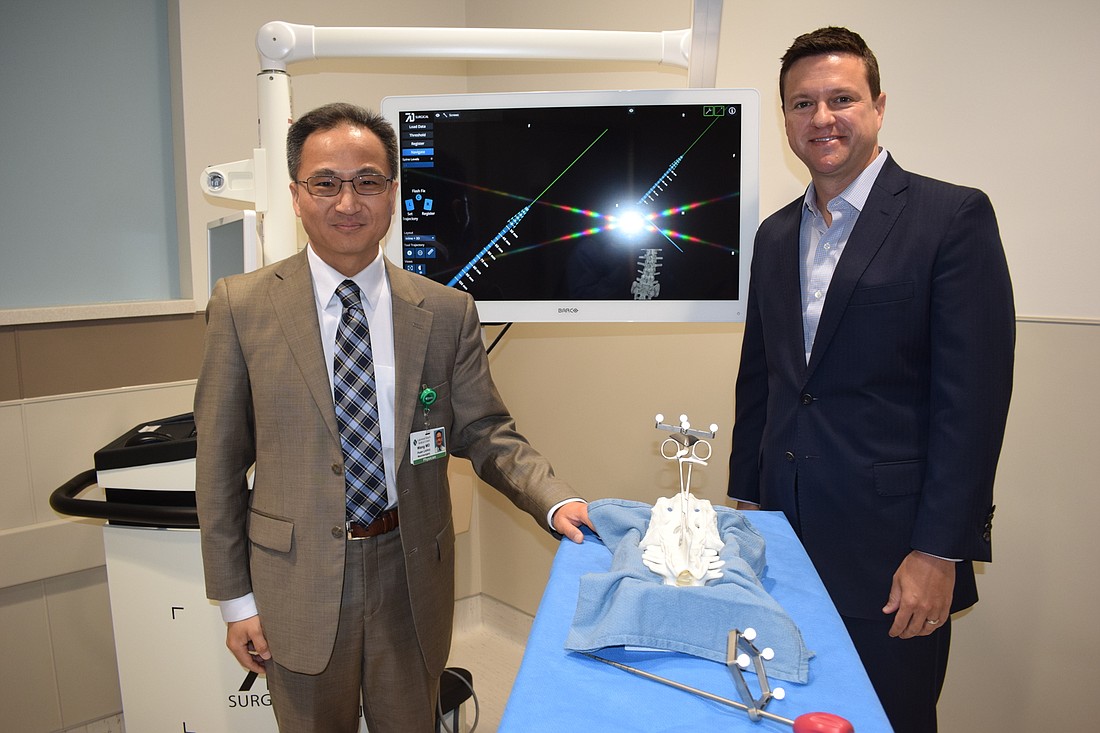- July 26, 2024
-
-
Loading

Loading

Standing by his company's breakthrough technology at Lakewood Ranch Medical Center, 7D Surgical Vice President Scott Young was trying to think of an easy way to describe a very complicated system.
"It is a GPS for the spine and the brain," Young said.
It's an oversimplified explanation, but a pretty good one, too. The Machine-Vision Image Guided Surgery Platform — the second in Florida (the other is in Orlando) — does all the complicated analysis and then shows surgeons where to go, and where not to go.
Young said it will make traditional spine surgeries more efficient and more accurate.
Dr. Huan Wang, a neurosurgeon, has used the new technology twice at Lakewood Ranch Medical Center, and while it certainly will draw rave reviews for its ability to guide surgeons, he said one of the most important aspects during spine surgery is it functions without radiation. It uses camera technology linked to a computer.
"The light is non-evasive," Wang said of the new technology. "A CT scan is like 500 chest x-rays all at once."
He said with many Americans living longer, the result of x-rays or radiation is being seen more these days. In the past, people would die before radiation damage would appear.
Young gave an exhibition March 5 of the Machine-Vision Image Guided Surgery Platform. He pulled down a oblong light that was above a table. He pointed at the two imbedded cameras that were surrounded by LED light bulbs. A flash of light sent the image of a model spine back to the computer to be analyzed.
The technology, of course, involves the ability of the computer to analyze the spine, or brain, and then present a roadmap for the surgeon on a screen at the head of the operating table. The whole process occurs in seconds, allowing the surgeon to go from analysis right into surgery.
In 7D's parlance, "the Proprietary Flash uses structured light during the automated registration process. Using only visible light, a 2D light pattern is projected onto the anatomy. The light pattern reflected from the anatomy’s surface is then digitized using a point cloud with over 300,000 points. The most optimal points are instantly selected and automatically matched with a pre-operative CT, creating the 3D image mapping for surgical navigation."
While patients must have a pre-op CT scan, they don't have x-rays during surgery with the new system, saving them from additional radiation.
Young said it is a marriage of reality and virtual reality.
"You are taking a photo of the patient's anatomy using the same technology that is used in self-driving autos," Young said. "In surgery, you're are taking a photo, and it's literally just a flash of light."
Wang said the system, which was developed in Toronto and is only the 22nd in operation in the U.S., was a bargain at $450,000 and Lakewood Ranch Medical Center CEO Andy Guz agreed.
"Dr. Wang and I had a conversation over two years ago, and this piece was critical," Guz said.
Guz had asked Wang to evaluate the hospital's service lines.
"I've been here since 2018 and there has been a lot of progression in terms of philosophical approach," Wang said. "The hospital has a progressive attitude. I was asked to evaluate technology that would be a key element. This technology gives us complex cranial spine capabilities.
"And this can't be done by just purchasing a piece of equipment. The CEO leads the culture and this takes a lot of vision, and confidence in your vision. This is not just a financial commitment, but a hospital commitment that goes far beyond. This involves nurse training and staff abilities and nurse critical care."
But Wang said the payoff is huge. He said the technology has a board spectrum of applications and he expects, in the future, a robotic arm will be used for some surgeries.